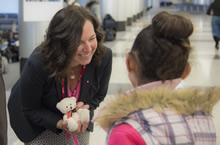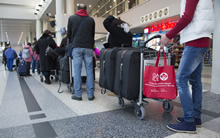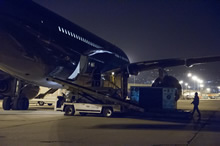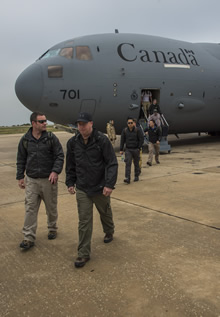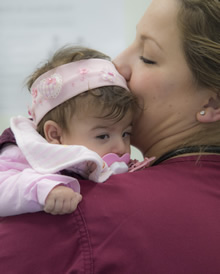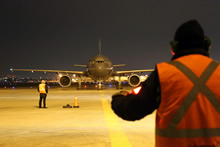Operation PROVISION
News
There are currently no matching articles. Please check again later.
Operation PROVISION was the Canadian Armed Forces’ (CAF) support to the Government of Canada’s initiative to resettle 25,000 Syrian Refugees in Canada by the end of February 2016.
Immigration, Refugees and Citizenship Canada (IRCC) was the lead department for Canada’s efforts with numerous supporting departments which included:
- Canada Border Services Agency (CBSA);
- the Department of National Defence (DND);
- Global Affairs Canada (GAC);
- Public Health Agency of Canada;
- Public Services and Procurement Canada;
- Public Safety Canada; and
- the Royal Canadian Mounted Police (RCMP);
The Canadian Armed Forces contribution
CAF personnel deployed on Operation PROVISION supported the lead government department, Immigration, Refugees and Citizenship Canada, with the processing of Syrian refugees destined to resettle in Canada.
The CAF was prepared to provide interim lodging for approximately 2,700 refugees at bases and facilities in Ontario and Quebec, with additional spaces available at facilities across Canada, if needed.
Accommodations at bases and wings were but one option explored to provide interim lodging to refugees as part of a broader Government of Canada initiative.
If requested, the CAF was prepared to provide interim lodging for refugees at the following bases/wings in Ontario and Quebec:
- Canadian Forces Base (CFB) Kingston; and
- 2nd Canadian Division Support Base Valcartier.
Approximately 300 CAF personnel deployed to Aerial Ports of Embarkation (APOEs) in Lebanon, Turkey and Jordan combined to support the Government of Canada initiative.
While tasks varied at each APOE, deployed CAF personnel had:
- Assisted the Canadian Defence Attachés (CDAs);
- Acted as Liaison Officers between the CDA and Canadian Joint Operations Command;
- Assisted IRCC with the administrative processing of refugee applications, including the collection of biometric data;
- Provided support for medical screening; and
- Provided a CAF command and control element.
Mission Context
Since the outbreak of the Syrian civil war in 2011, millions of people had fled the country seeking safety and resettlement internationally. According to the United Nations High Commissioner for Refugees, since the beginning of 2015, more than 720,000 refugees and migrants had crossed the Mediterranean, undertaking journeys from Syria, Iraq, Afghanistan, Sudan, and other regions torn apart by war, hunger and violence.
Canada’s response
On 9 November 2015, the Government of Canada officially announced its commitment to welcome approximately 25,000 Syrian refugees from Lebanon, Turkey, and Jordan to Canada by the end of February 2016, with an initial group of 10,000 arriving by 31 December, 2015.
The Government of Canada plan had five phases:
- identifying Syrian refugees to come to Canada;
- selecting and processing Syrian refugees overseas;
- transportation to Canada;
- arrival and welcoming in Canada; and
- settlement and community integration.
The Government of Canada also worked alongside non-governmental organizations including the United Nations Refugee Agency, the International Red Cross, and Canadian companies, charities, and service providers
Mission timeline
- 9 November 2015 – the Government of Canada announced the creation of a new Cabinet ad hoc committee to help bring Syrian refugees to Canada.
- mid-November 2015 – the CAF deploys 12 personnel to assist Canadian Defence Attachés (CDAs) in Lebanon, Jordan and Turkey and to act as Liaison Officers between the CDAs and Canadian Joint Operations Command.
- 28 November 2015 – the CAF deploys members of 2nd Battalion, the Royal Canadian Regiment based at 5th Canadian Division Support Base Gagetown, to assist IRCC with the screening of refugees in Lebanon and Jordan.
- 01 December 2015 – the CAF continues to deploy medical specialists and other personnel to assist IRCC in Lebanon and Jordan, as requested.
- 10 December 2015 - the first CAF refugee flight, a CC-150 Polaris, leaves Lebanon for Toronto.
- 12 December 2015 – the second CAF refuge flight, a CC-150 Polaris, leaves Lebanon for Montreal.
- 12 January 2016 – CAF members begin gradual redeployment to Canada.
- 29 February 2016 – Close out of CAF assistance overseas.
- 3 March 2016 – Interim Lodging Sites at Canadian Armed Forces Bases are stood-down.
- 4 March 2016 – Remaining deployed CAF personnel return home.
- 9 May 2016 – 16 CAF personnel deploy to Beirut to assist IRCC in processing applications.
- 18 June 2016 – Deployed CAF personnel return home.
Previous CAF support to emergency humanitarian evacuations
Operation PARASOL (1999) – The Canadian Forces was called upon to support the Government of Canada’s efforts to assist displaced refugees from the Serbian province of Kosovo. As part of Operation PARASOL, more than 5,000 Kosovar Albanian refugees were airlifted to Canada and temporarily accommodated at various bases across the country.
Operation MAGNET (1978) - Following the collapse of the South Vietnamese government and the fall of Saigon in 1975, the Government of Canada through the Canada Employment and Immigration Commission and Department (CEICD) and the Canadian Forces arranged for the airlift and resettlement of over 50,000 people from Vietnam. Op MAGNET occurred in three phases from 1978-1981.
External links
Government of Canada
#WelcomeRefugees (Government of Canada)
Announcement of action on Syrian refugee crisis (IRCC)
Conflict in Syria (DFATD)
External Links
Syria Regional Refugee Response (UNHCR)
